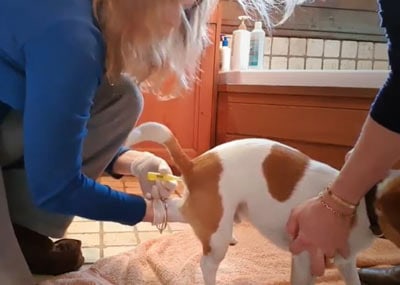How To Tell If Your Pet Is Sick So You Can Stress Less
Sometimes it can be touch to tell if your pet is sick.
If you’ve ever taken care of a pet, you know the feeling— something seems off, but can’t quite figure out what it is.
It’s frustrating and stressful, leading to a flood of questions:
“Am I overreacting?”
“Should I rush to the vet?”
Maybe you’ve even considered turning to social media for advice.
Spoiler alert: that’s usually not the best approach.
This article will help you recognise when your pet might be unwell, how to trust your instincts, and what steps you can take to ease your worries while keeping your pet safe and healthy.

[easy-social-share]
Trust Your Instincts: You Know Your Pet Best
When your pet starts acting differently, it’s often more of a gut feeling than a clear sign of illness.
Veterinarians call this—ADR, which stands for “Ain’t Doing Right.”
You might not know exactly what’s wrong, but you sense something isn’t right.
Some common signs may include:
- Behavioural changes: Is your pet suddenly clingy or distant?
- Posture: Do they sit oddly or hold their head to one side?
- Energy levels: Are they more lethargic or sleeping more than usual?
- Appetite: Are they eating less, being picky or refusing food?
- Social interactions: Are they less excited to greet visitors?
Pets, can be very good at hiding their pain due to their evolutionary instincts. This can make it difficult to notice signs of illness until it’s too late.
Additionally, some pets are more stoic than others, so even if they don’t show obvious symptoms, they could be quite sick.
Keep Records: Monitor Your Pet’s Health
One of the best ways to ease your stress is is by keeping detailed records.
This not only helps you monitor their well-being over time but also provides valuable information if a visit to the vet becomes necessary.
Here’s how to start:
1. Track Food and Preventative Care
Record details about:
- Food: Brand, amount, and feeding frequency.
- Preventative care: Flea, tick, and worm treatments, along with the dates given.
- Vaccinations: Note the type of vaccination and the date administered.
Keeping this information in your phone or a notebook makes it easy to access and share with your vet.
Setting up reminders for tick and heartworm protection ensures your pet stays safe.

2. Monitor Eating, Drinking, and Bathroom Habits
Track how much your pet eats and drinks daily, as well as their bathroom habits:
- Poop and pee: Note frequency, consistency, and colour.
Taking photos of their stool can help you notice any changes and can be helpful when discussing concerns with your vet.
Perform a Basic Health Check At Home
While vets conduct detailed exams, you can perform basic health checks at home.
This allows you to catch potential problems early.
1. Get a Thermometer
Purchase a pet-specific thermometer and label it for your dog or cat to avoid using it on humans.
Use it to check your pet’s temperature if they seem unwell.
The normal temperature range for dogs and cats is 37.5°C to 39.5°C. Anything outside of this range should raise concern.

Have on hand a thermometer so that you can take your pet’s temperature.
2. Conduct A Nose-to-Tail Exam
Perform a weekly check on your pet to familiarise yourself with their normal health.
Here’s what to look for:
- Eyes: Check if they’re clear, bright, and free from discharge.
- Ears: Make sure they’re clean with no foul smells or discharge.
- Mouth: Check that teeth are clean, and there are no broken teeth or bad odours.
- Gums: Healthy gums should be pink and moist. If they’re pale, blue, or yellow, contact your vet immediately.
- Coat and skin: Look for lumps, bumps, fleas, or ticks. Measure any lumps and take note of their location.
- Heart rate: Feel your pet’s heartbeat by placing your hand on their chest. Count beats for 15 seconds and multiply by four. Large breeds have heart rates between 60-100 bpm, while smaller breeds range between 100-140 bpm.
- Respiratory rate: Count how many times their chest rises or falls in 15 seconds and multiply by four. Notice if they are breathing heavily or using their abdominal muscles to breathe.
- Limbs and movement: Observe their walk and check for any limping or discomfort. Flex their joints to see if they react to pain.
Regularly performing this type of exam will familiarise you with what’s normal for your pet, making it easier to detect any changes early before they become serious.
Our article on vital signs can help you to understand the clinical examination in more detail.
Don’t forget to download this checklist to help you record your pet’s vital signs.

Yellow gums are a sign of jaundice.
Know When to Seek Veterinary Care
Whenever you notice something unusual, it’s important to consult a vet. Early intervention can often prevent more serious issues.
If you’re unsure about whether to take your pet to the vet, consider using Your Vet Online, which provides 24/7 access to veterinarians. You can discuss your concerns and get peace of mind without leaving your home.
Key Takeaways:
- Trust your instincts: You know your pet better than anyone, so pay attention to any changes in their behaviour.
- Perform regular health checks: A weekly nose-to-tail exam helps you spot potential issues early.
- Keep detailed records: Track food, preventative care, and health habits to make informed decisions.
- Seek help promptly: Don’t wait—early treatment can prevent more serious problems.
By following these steps, you’ll feel more confident in caring for your pet and ensuring their long-term health.




Leave A Comment